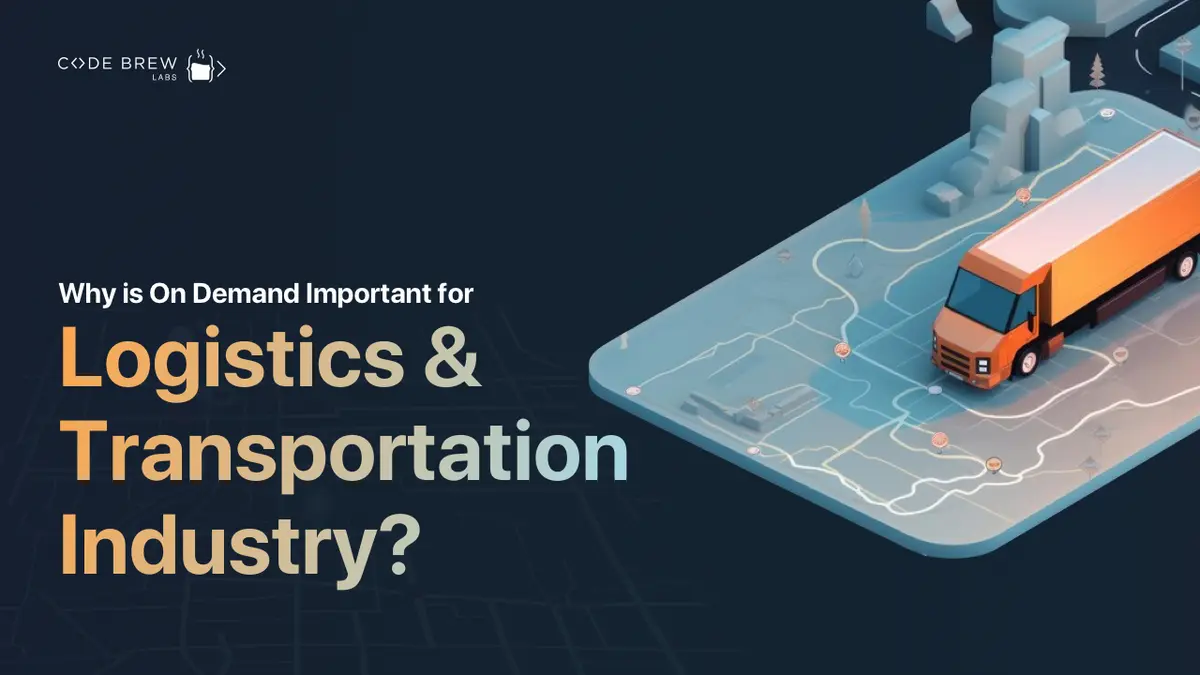
With the on-demand supply curve steepening more towards customer-centricity, on-demand businesses are also experiencing a consistent growth trajectory.
Table of Contents
On-demand businesses are structured around a business model that offers quick and convenient delivery of products or services at the customer’s doorstep. This model efficiently addresses evolving customer needs by pivoting around speed and easy access.
Under it, customers can pick products of their choice, place orders, and pay digitally in only a few clicks to get their orders delivered in, at the most, 60 minutes! They can do all this while tracking their orders in real-time.
The same is the case with on-demand services. Take Airbnb, for example. Travelers can conveniently book a staycation for a few days or weeks at their convenience at affordable rates.
Considering the surge of the on-demand market, the logistics market is also witnessing a simultaneous rise. And together, the on-demand logistics duo is offering entrepreneurs unprecedented levels of efficiency, convenience, and cost-effectiveness.
And research states that the global on-demand logistics market is projected to reach $80.6 billion by 2031. Such favorable statistics suggest that it’s the right time for business owners to take the million-dollar leap and invest in an on-demand logistics app.
The industry has more or less evolved from a modern business strategy that enables companies to fulfill client orders on the same day.
The entire order placement to delivery cycle is completed by an on-demand logistics dream team that helps both stakeholders–on-demand company and logistics company–exponentially expand their customer reach and achieve economies of scale.
This innovative business model also supports multichannel retailing. Under this, multiple sales channels synchronously fulfill client orders in a streamlined and automated manner. The smooth flow of operations is supported by a robust distribution network and advanced technologies like cloud computing and analytics.
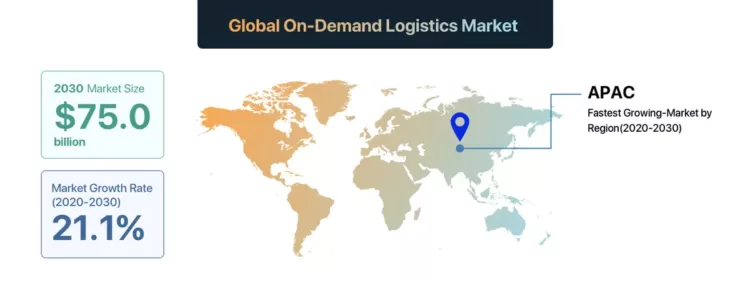
E-commerce is the fastest-growing driver behind the rise of the on-demand industry. Further, with increasing digitization and socioeconomic trends strengthened by the COVID-19 pandemic, online buying is now possible for almost all products and services.
Customers now have fast and convenient options to fulfill their purchase needs from almost anywhere. They are connected with suppliers via digital platforms like a website or an app.
These platforms facilitate the entire process: from displaying listings on an e-commerce marketplace to order placement, making payments, communicating with delivery personnel, tracking status, and even collecting feedback.
All in all, consumer behavior, in general, is constantly shifting towards prioritizing fast, simple, and fulfilling experiences. And this behavioral trend has been offset globally since the rise of the Internet in the late 1990s.
Traditional logistics processes across the world are still wrought with pitfalls like high cost of ownership, lack of reliable service-level agreements, and hectic paperwork.
Further, conventional logistics services are asset-heavy. As such, the assets go through a lot of wear and tear to achieve maximum operational efficiency.
Meanwhile, they also undergo absolute underutilization during low-demand periods. This leads to their depreciation at increasing rates, which eventually means high maintenance costs.
In either case, there is an adverse use of fleet capacity. But the logistics industry’s alliance with the on-demand industry has propelled the former to up the ante by leveraging technologies like GPS tracking and AI and ML.
So now, collaboratively, both industries are meeting dynamic customer expectations by working in tandem with each other. This, in itself, is a huge win.
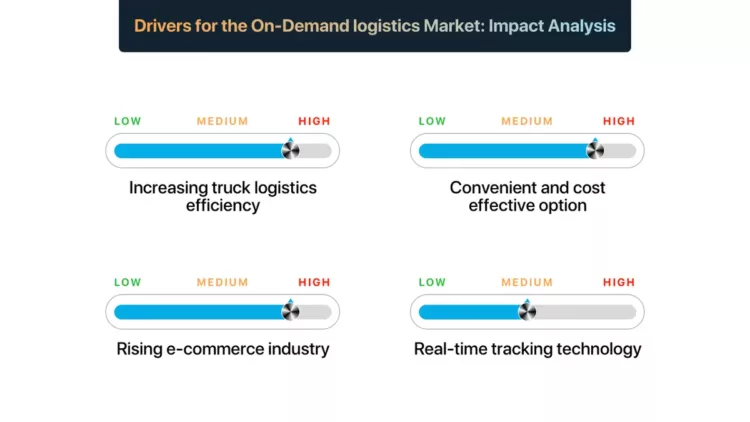
Besides this, the on-demand industry has contributed to the expansion of the logistics industry in many other ways:
Real-time data and interactive analytics help brands enhance their on-demand logistics efficiencies.
Leveraging analytics helps build insights and uncover patterns regarding customers, trends, and processes. For instance, fleet managers can get to know how many resources it takes to serve particular customers in various regions.
Once they identify the approximate figure, they can define and implement better route management strategies while saving costs.
Tracking metrics also enables logistics companies to anticipate service issues due to sudden demand spikes, natural calamities, and other such disruptions. Accordingly, companies can proactively notify their clients of such situations and, thus, build strong brand credibility.
What’s best? This, in turn, improves the customer acquisition and retention rate.
The massive amounts of orders and service requests have compelled logistics companies to invest in lucrative fleet management software. Real-time fleet tracking (one of the core features of such software) allows companies to manage all their vehicles efficiently.
Besides, fleet and warehouse managers can stay connected with delivery personnel 24X7 and even keep track of their work and idle hours.
Moreover, drivers get to know the shortest routes and diversions. This helps them avoid roadblocks and deliver orders on time. This results in a higher level of customer satisfaction and facilitates the logistics companies to get a competitive edge.
The on-demand industry keeps customers convenience at its core. It allows clients to select from a wide range of service providers and get complete visibility into the supply chain, thanks to the feature of real-time shipment tracking.
Besides providing them with transparency, the industry also encourages consumers to give feedback. This essentially means that clients identify the areas of improvement in the supply chain.
On-demand brands work on consumer feedback, analyze the deficit in meeting client expectations, and accordingly take action to better the customer experience.
This consumer-centricity is the logistics industry’s key learning from the on-demand industry.
Though at the micro level, there are many use cases, all of them more or less fall under two categories:
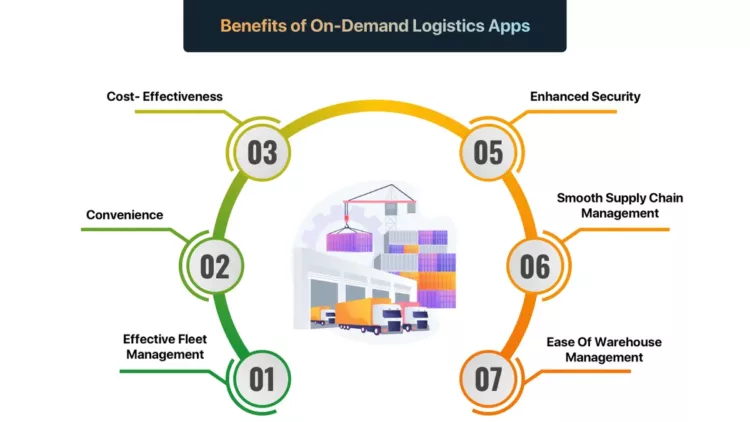
Ever since the pandemic, there has been a great demand for on-demand logistics services in healthcare. There is a dire need for logistics systems that are flexible and responsive to the patient’s needs.
Something as simple as an ambulance arriving on time can fetch great results in terms of patient outcomes. Patient satisfaction will drastically improve if medications and other supplies are delivered promptly.
And with rising healthcare costs and increasing supply chain complexity, on-demand logistics is likely to become even more crucial in healthcare.
Retailers are under a lot of pressure to efficiently deliver orders and provide services on time while managing their brick-and-mortar locations. This mounting pressure has compelled most retailers to partner with on-demand logistics companies to effectively meet these challenges.
On-demand logistics companies offer a wide range of services–from same-day delivery to last-mile delivery. Besides, these services help retailers deliver products to customers quickly without requiring the retailers to invest in their delivery infrastructure.
Thirdly, these companies help retailers manage demand spikes by providing extra resources on an as-and-when-needed basis.
Today, customers use only those e-commerce brands or platforms that guarantee faster order delivery and fulfillment. But, at the brand’s end, speeding up the delivery process can bring a huge cut in the overall delivery budget.
A lucrative solution to this problem is to partner with an on-demand logistics company that follows an inventory distribution model. Such a company has links with thousands of merchants. It offers them discounted shipping rates in return for using compact spaces in their fulfillment centers or warehouses.
So, by partnering with on-demand logistics companies, e-commerce brands can make the entire delivery experience seamless and achieve maximum customer satisfaction.
Here are the other ways in which on-demand logistics can improve the overall customer experience:
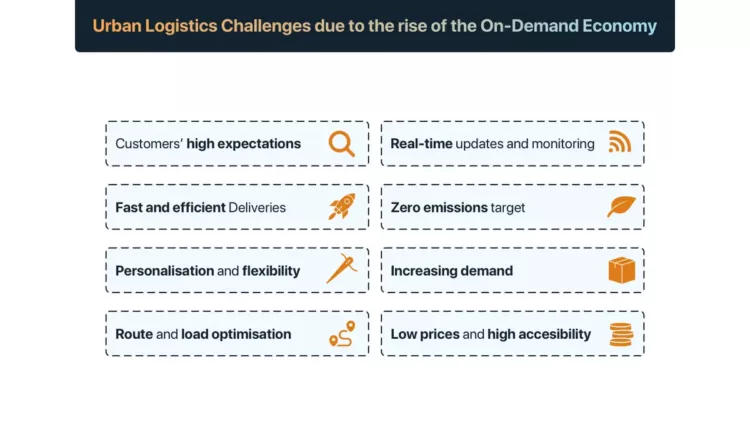
Giving the responsibility of your logistics management to an on-demand logistics service provider gives you 360-degree visibility of the inbound & outbound logistics operations.
Thus, you can easily track your clients’ orders and ensure that these reach the customers’ doorsteps without any damage and on time. Besides, you can single out and fix delivery problems (if any) as and when they occur.
As a rule, every customer wants the order to be delivered as soon as it is placed. A majority of online buyers leave their shopping carts if they aren’t satisfied with the expected date of order delivery.
Realistically speaking, it is generally not feasible for an e-commerce company to offer same-day or next-day delivery across every region they serve.
But on-demand logistics can overcome this challenge too. Eventually, as e-commerce companies deliver orders as per demand, the shipping and delivery process also becomes faster.
Order fulfillment cost includes the cost of warehousing, processing orders, storing & managing inventory, and packaging & shipping orders.
Partnering with an on-demand logistics company relieves brands from the burden of investing in logistics infrastructure and hiring professionals to manage inventory.
Besides, the logistics partner distributes the SKUs to various fulfillment centers across a particular region. This ensures on-time delivery of the ordered products.
One of the most discussed logistics tech trends of today is autonomous trucks and vehicles. This technology bridges the gap between the number of drivers on duty and the rising demand for delivery services.
Further, these vehicles also come to the rescue of fleet managers when there are maintenance issues. And if any vehicle in the fleet gets damaged in an accident or any other calamity, autonomous trucks and vehicles take such mangled vehicles to the warehouse for repair.
Another futuristic logistics trend is AI-powered robots. Experts say that they are going to change the face of logistics and courier service businesses. Besides improving customer experience, these robots will also speed up business processes, enhance route planning, and offer more convenience.
Experts also speculate that drones will accelerate the delivery process, free up technician workload, document fleet vehicle damage and even lower the overall maintenance cost.
If you are inspired to improve your existing business processes, do consider hiring Code Brew Labs for all your tech solution needs.
We have a team of over 650 industry-vetted developers who leave no stone unturned in building a robust platform that brings you real business results.
Feel free to discuss your business needs with our team and get a quote by reaching out to us.
